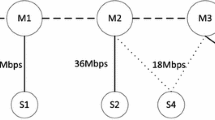Abstract
In this paper, the problem of resource allocation in an Orthogonal Frequency Division Multiple Access-based Cognitive Wireless Mesh Network (CWMN) is addressed. The objective is to maximize the total utilities in a CWMN, which is defined as any increasing, concave and twice differentiable function of the end-to-end flow rate, by jointly allocating each link’s rate, power and subchannels under the constraints of multiple primary users’ Interference Temperature and multiple access interference. First, a centralized resource allocation algorithm is developed based on the Column Generation approach, and shown to be optimal. So it can perform as a criterion for designing other algorithms. Secondly, considering the applicability of algorithm in distributed system, a near-optimal distributed algorithm is proposed, which allocates subchannel based on routing information at first, and then jointly allocates the resource of rate and power. Finally, the simulation results validate the centralized and distributed algorithms, and show that better performance can be achieved than the conventional algorithm.
Similar content being viewed by others
References
Faccin S.M., Wijting C., Kenckt J., Damle A. (2006) Mesh WLAN networks: Concept and system design. IEEE Journal of Wireless Communications 13(2): 10–17
Bruno R., Conti M., Gregori E. (2005) Mesh network: Commodity multihop ad hoc networks. IEEE Communications Magazine 43(3): 123–131
Mitola J., Maguire G. Q. (1999) Cognitive radio: Making software radios more personal. IEEE Personal Communications 6(4): 13–18
Mitola, J. (2000). Cognitive radio: An integrated agent architecture for software defined radio. Doctor of Technology, Royal Institute Technology (KTH), Stockholm Sweden.
Federal Communications Commission. (2003). Cognitive radio technologies proceeding. Report ET Docket, No. 03–108.
Haykin S. (2005) Cognitive radio: Brain-empowered wireless communications. IEEE Journal on Selected Areas in Communications 23: 201–220
Federal Communications Commission. (2002). Spectrum policy task force. Report ET Docket.
Brodersen, R. W., Wolisz, A., Cabric, D., Mishra, S. M., & Willkomm, D. (2004). Corvus: A cognitive radio approach for usage of virtual unlicensed spectrum. [online]. Available: http://bwrc.eecs.berkeley.edu/Research/MCMA/CR_White_paper_final1.pdf
Ghasemi A., Sousa E. S. (2007) Fundamental limits of spectrum-sharing in fading environments. IEEE Transactions on Wireless Communications 6: 649–658
Huang J., Berry R. A., Hong M. L. (2006) Auction-based spectrum sharing. Mobile Networks and Application 11: 405–418
Xing Y., Mathur C. N., Haleem M. A., Chandramouli R., Subbalakshmi K. P. (2007) Dynamic spectrum access with QoS and interference temperature constraints. IEEE Transactions on Mobile Computing 6: 423–432
Cheng P., Zhang Z., Chen H.-H., Qiu P. (2008) Optimal distributed joint frequency, rate, and power allocation in cognitive OFDMA systems. IET Communications Special Issue on Cognitive Spectrum Access 2(6): 815–826
Chowdhury R., Akyildiz F. (2008) Cognitive wireless mesh networks with dynamic spectrum access. IEEE Journal on Selected Areas in Communications 26(1): 168–181
Sharma, M., Sahoo, A., & Nayak, K. (2007). Channel selection under interference temperature model in multi-hop cognitive mesh networks. In IEEE International Conference on Dynamic Spectrum Access Netwroks (DYSPAN).
Thomas Y., Shi Y., Sherali D. (2008) Spectrum sharing for multi-hop networking with cognitive radios. IEEE Journal on Selected Areas in Communications 26(1): 146–155
Zhang, J., Zhang, Z., Luo, H., & Huang, A. (2008). A column generation approach for spectrum allocation in cognitive wireless mesh network. In Proceedings of IEEE GLOBECOM 2008, Nov 30–Dec 4.
Ramanathan, R., & Lloyd, E. L. (1993). Scheduling algotithms for multi-hop radio networks. In Proceedings of IEEE/ACM Transactions on Networking.
Wong C. Y., Cheng R. S., Letaief K. B., Murch R. D. (1999) Multiuser OFDM with adaptive subcarrier, bit, and power allocation. IEEE Journal on Selected Areas in Communications 17: 1747–1758
Perkins, C., Belding-Royer, E., & Das, S. (2003). Ad hoc on-demand distance vector (AODV) routing. RFC 3561, July 2003, [Online]. Available: http://rfc.sunsite.dk/rfc/rfc3561.html.
Clancy T. (2007). Formalizing the interference temperature model. Wiley Journal on Wireless Communications and Mobile Computing 7(9):1077–1086.
Garey M. R., Johnson D. (1979) Computers and intractability: A guide to the theory of NP-completeness. W. H. Freeman and Company, New York, pp 245–248
Bjrklund, P., Vrbrand, P., & Yuan, D. (2003). Resource optimization of STDMA in ad hoc networks. Technical report, Deportment of Science and Technology, Linkping university, Sweden.
Johansson M., Xiao L. (2006) Cross-layer optimization of wireless networks using nonlinear column generation. IEEE Transaction on Wireless Communications 5(2): 435–445
Boyd S., Vandenberghe L. (2004) Convex optimization. Cambridge University Press, Cambridge
Gilmorre P. C., Gomory R. E. (1961) A linear programming approach to the cutting stock problem. Operations Research 9: 849–859
Shih W. (1979) A branch and bound method for the multiconstraint zero-one knapsack problem. Journal of Operational Research Society 30: 369–378
Le, L. B., & Hossain, E. (2007). Joint rate control and resource allocation in OFDMA wireless mesh networks. Wireless Communications and Networking Conference (pp. 3041–3045).
Goldsmith A., Chua S. G. (1997) Variable-rate variable-power MQAM for fading channels. IEEE Transactions on Communications 45: 1218–1230
Author information
Authors and Affiliations
Corresponding author
Additional information
This work was supported in part by National Basic Research Program of China (973 Program) (No. 2009CB320405), National Natural Science Foundation of China (No. 60972057), and National High Technology Research and Development Program (863 Program) (No. 2007AA01Z257), China.
Rights and permissions
About this article
Cite this article
Zhang, J., Zhang, Z. & Luo, H. Joint Subchannel, Rate and Power Allocation in OFDMA-Based Cognitive Wireless Mesh Network. Wireless Pers Commun 57, 501–520 (2011). https://doi.org/10.1007/s11277-009-9858-1
Published:
Issue Date:
DOI: https://doi.org/10.1007/s11277-009-9858-1




